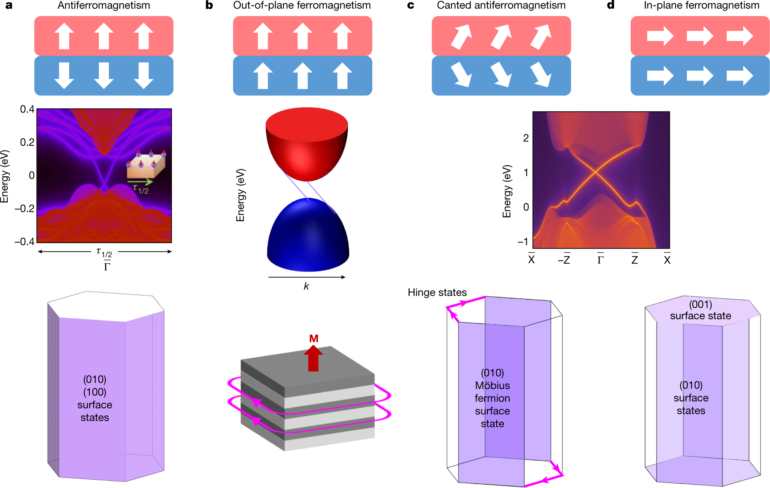A new review paper on magnetic topological materials introduces a theoretical concept that interweaves magnetism and topology. It identifies and surveys potential new magnetic topological materials and suggests possible future applications in spin and quantum electronics and as materials for efficient energy conversion.
Magnetic topological materials represent a class of compounds whose properties are strongly influenced by the topology of the electronic wavefunctions coupled with their spin configuration. Topology is a simple concept dealing with the surfaces of objects. The topology of a mathematical structure is identical if it is preserved under continuous deformation. A pancake has the same topology as a cube, a donut as a coffee cup, and a pretzel as a board with three holes. Adding spin offers additional structure—a new degree of freedom—for the realization of new states of matter that are not known in non-magnetic materials. Magnetic topological materials can support chiral channels of electrons and spins, and can be used for an array of applications including information storage, control of dissipationless spin and charge transport, and giant responses under external stimuli such as temperature and light.
The review summarizes the theoretical and experimental progress achieved in the field of magnetic topological materials beginning with the theoretical prediction of the quantum anomalous Hall effect without Landau levels, leading to recent discoveries of magnetic Weyl semimetals and antiferromagnetic topological insulators. It also outlines recent tabulations of all magnetic symmetry group representations and topology. As a result, all known magnetic materials—including future discoveries—can be fully characterized by their topological properties. The identification of materials for a specific technological application (e.g., quantum anomalous Hall) is straightforward. Using this approach, magnetic topological materials with magnetic transition temperatures above room temperature can be identified, or if necessary, designed for classical applications such as thermoelectric devices, Hall sensors or efficient catalysts, but they are also useful for quantum applications at low temperatures, including computing and sensing.
Andrei Bernevig says, “The realization of the QAHE at room temperature would be revolutionary, overcoming limitations of many data-based technologies, which are affected by power losses from Joule heating.”
His colleague Stuart Parkin of the Max PIanck Institute of Microstructure Physics, Halle, Germany, says, “The novel properties of this new class of magnetic materials can pave the way to new generations of low-energy-consuming quantum electronic and spintronic devices and even novel superconducting spintronic devices.”
Claudia Felser, MPI CPfS is most excited about their potential applications in chemistry. She says, “If we can design a magnetic catalyst for water splitting we might be able to change the catalytic properties with an external field, which would allow us to switch on and off catalysis.”
Haim Beidenkopf says, “The design of a material that exhibits a high temperature quantum anomalous Hall via quantum confinement of a magnetic Weyl semimetal and its integration into quantum devices is my main goal for the future.” The field of magnetic topological materials clearly has and will have impact in both the scientific and technological worlds.
The study is published in Nature.
More information:
Bogdan Bernevig, Progress and prospects in magnetic topological materials, Nature (2022). DOI: 10.1038/s41586-021-04105-x. www.nature.com/articles/s41586-021-04105-x
Provided by
Max Planck Society
Citation:
Progress and prospects in magnetic topological materials (2022, March 2)
